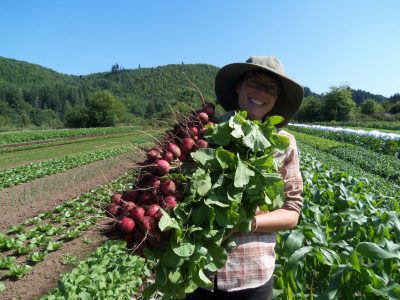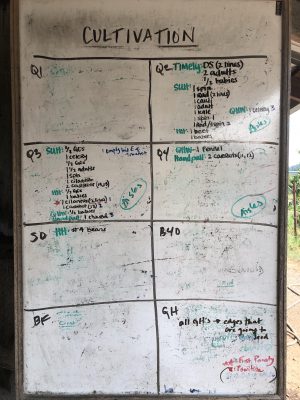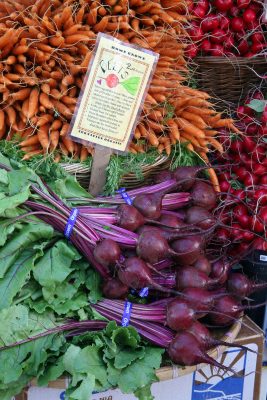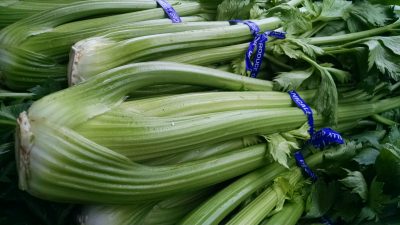We are starting the 2nd half of the CSA season and there is so much to look forward too. This week, you’ll get to enjoy the first of the sweet corn. Yum! On the farm, we are really feeling the busy season. Fast-paced work, big harvests and lots of weeding are the norm. We’re sore, tired and enjoying the work. Cheers to local, organic produce and thank you for supporting Horton Road Organics!
What’s in Box #11?
Salad Mix: More delicious greens for you this week. For best storage, keep greens in the fridge, in a plastic bag or other covered container, with just a little bit of moisture to prevent wilting.
Carrots: Nelson variety. They have a delicious sweet flavor and crunch. These can last quite a while (months!) in the fridge if they are kept covered in a plastic bag.
Cilantro: Marino variety. For best storage, keep in a covered container or plastic bag in the fridge, with just a little moisture or in a jar like cut flowers. Cilantro will not keep as well as basil or parsley, so plan to use in a timely manner.
Swiss Chard: Bright Lights variety. We are just starting to harvest our new bed of chard that will last us through the Fall and the leaves are a little delicate right now.
Sweet Corn: The first of the season. Enjoy this new variety of white corn that we are growing this year, Temptress!
Green Onions: Parade variety. A perfect addition to so many dishes. We are overloaded right now!
Radishes: Cheriette variety. For longer storage, remove the greens. The heat (temperature) brings out the heat (flavor). So, expect these to have a little kick.

Recipes:
In-Husk Grilled Corn with Herb Butter
https://www.epicurious.com/expert-advice/how-to-grill-corn-on-the-cob-with-husks-article
Grilling ears corn while still in the husk will give them a smoky flavor as the husks allow smoke to permeate the corn, as opposed to using tin foil. The husks also protect the corn from direct heat from the grill while steaming the corn efficiently. ~ Derek
To prepare the husk, pull it back and leave it still attached at the bottom of the cob. Remove the corn silks from the cob and then spread with seasoning. For this step, try the herb butter below! Pull the husk back into place and grill for about 10 minutes on medium-high heat or until the corn is tender (husks will be charred and beginning to shrivel).
Ingredients:
1/2 cup (1 stick) unsalted butter, room temperature
2 tablespoons finely chopped fresh tender herbs (such as cilantro, chives, and/or parsley)
1 1/2 teaspoon kosher salt
1/2 teaspoon ground black pepper
Cayenne pepper to taste
8 ears corn, shucked
1 tablespoon vegetable oil
Preparation:
Prepare grill for medium-high heat. Mix butter, herbs, salt, pepper, and a pinch of cayenne pepper in a small bowl. Set herb butter aside.
♦ ♦ ♦ ♦ ♦ ♦ ♦
Reiden’s Cilantro Salsa
I recently invested in a food processor and was happy to find that salsa making is now so much faster. While this salsa contains several components, the cilantro definitely takes center stage (as it should in my opinion). I’ve found that it works best to process the garlic and onion by themselves first, then add everything else. –Reiden
Ingredients:
3 roma tomatoes
3 jalapenos (mild peppers can be substituted)
1 large bunch of cilantro
4 garlic cloves
½ large yellow onion
1 t cumin
1 t salt (I usually use more, but some people prefer less)
½t black pepper
♦ ♦ ♦ ♦ ♦ ♦ ♦
Spicy Asian Stir-Fried Swiss Chard
https://kalynskitchen.com/recipe-for-spicy-asian-stir-fried-swiss/
This recipe uses both the stems and leaves of the chard so nothing is going to waste. For storing fresh swiss chard, place unwashed chard in a plastic storage bag, squeeze as much of the air out of the bag as possible, and place in the refrigerator for up to 5 days. ~ Taylor





